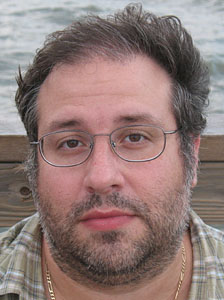People
Mark Besonen, Assistant Professor of Earth System Science

Greetings! Here's a mini bio to give you some details about my background.
I started as an undergraduate at Tufts University in Medford, MA where I earned my bachelors degree in Geological Sciences and Classical Archaeology. I stumbled across both of these fields during intro level classes in each during the second semester of my freshman year. It was obvious how both fields could be meshed, both contributing to and benefiting from one another, and I quickly fell in love!. Fortunately, the undergraduate programs in geology and archaeology at Tufts are superb, and this type of cross-disciplinary exploration was encouraged. On the archaeology side, I had the chance to work quite closely with Miriam Balmuth, a fantastically rewarding opportunity. And the same happened in geology where I had the opportunity to do a senior research project under the guidance of varve-master Jack Ridge. The *really* long title of that project was "Correlation of deglacial events in the Champlain Lowlands with the western St. Lawrence and Ontario Lowlands facilitated by paleomagnetic analysis of varved lake deposits", and some day when I get a chance I'll try to get it posted. Working with Jack and glacial varves provided a great introduction to high resolution paleo studies, and really shaped my interests for the future.
The promise of more closely interfacing geology and archaeology sent me to the Department of Geological Sciences at the University of Minnesota Duluth to work on a masters degree with George (Rip) Rapp, Jr. Rip arranged for me to work on an aspect of the Nikopolis Project, a multidiscliplinary archaeological survey of southern Epirus (Greece) directed by James Wiseman of the Boston University Department of Archaeology. My study dealt with the middle and late Holocene geomorphic evolution and paleogeography of the lower Acheron River Valley in Epirus. By using basic physical sedimentology and principles of stratigraphy, and ostracods and forams as salinity indicators, I was able to determine paleoenvironments of deposition, and reconstruct the shoreline position and landscape evolution in the valley over the last ~5,000 years. The project turned out to be a wonderful synthesis between geology and archaeology (i.e. geoarchaeology), and was well worth braving two years of bitterly cold Duluth winters! A link to further details about thist project, and publications in Adobe Acrobat PDF file, can be found on the Research and Projects page.
After Duluth, I headed to the Department of Geosciences at the University of Massachusetts Amherst to pursue a doctorate under the guidance of Ray Bradley. Besides taking me back to Massachusetts, it also plunged me headfirst back into an intimate, intense, and extended bout of high resolution paleo work related to varved sediments. In particular, it involved the annually-laminated sedimentary record from the Lower Mystic Lake (Medford/Arlington, MA). This record extends back about ~1,000 years before present, and archives a stunning lacustrine account of the birth and development of the Boston metropolitan area. The record also contains a series of anomalous graded beds. I was able to relate these graded beds to intense hurricane precipitation and wind-driven vegetation disturbance, and thus, develop a high-resolution record of hurricane and other large storm activity in Massachusetts and southern New England over the last millennium. More information about this can be found on the Research and Projects page.
My interest in geoarchaeological work continued during my doctorate work, and I became involved in some really interesting projects based in Turkey, Greece, and Syria. Links to information about these projects can be found on the Research and Projects page.
After finishing my doctorate, I stayed on at UMass for some post-doc work involving varved lacustrine sediments from the Canadian High Arctic. I also attempted to start up some high-resolution speleothem work from the Mediterranean right before starting a job at Texas A&M University—Corpus Christi in fall 2009. I am currently an Assistant Professor of Earth System Science in the Department of Physical and Environmental Sciences here.
It's probably clear that my main research interest is focused towards paleo studies. In particular, I use mostly sedimentary records (high-resolution if available) to interpret and reconstruct Holocene paleoenvironments and paleoclimatology. And if this work can be related to archaeology, all the better!
Last updated January 2012.